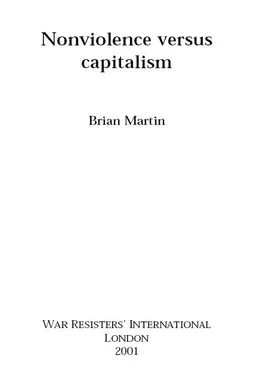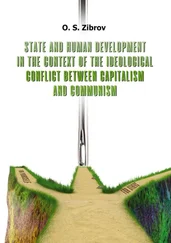There are many ways to analyse capitalism, so in choosing or developing an analysis it is essential to keep in mind what it is to be used for. The analysis of capitalism in this chapter is for the purpose of improving nonviolence strategy against capitalism. Three areas were singled out: the role of state power, founded in violence, in protecting private property and the capitalist system more generally; the shaping of belief systems to support capitalism; and the squashing or cooption of alternatives to capitalism. Later, in chapters 6 to 12, strategies will be examined to see whether they address one or more of these areas. In this sense, the analysis of capitalism presented here is one made from the viewpoint of nonviolence strategy. Another connection between the analysis of capitalism and the assessment of strategy comes through the five principles for assessing economic alternatives, applied in this chapter to capitalism and in chapter 5 to nonviolent economic models.
It is important to remember that capitalism is not the only system of domination, nor necessarily the one with greatest centrality or priority. Therefore anticapitalist strategies need to be developed in conjunction with strategies against other forms of domination. Nonviolence has the great advantage of being applicable, as both method and goal, to a whole range of systems of domination.
4. Conventional anticapitalist strategies
Since its very beginning, there has been opposition to capitalism, due to its disruption of communities, exploitation and creation of poverty. In spite of courageous resistance, capitalism in a matter of a few centuries has become the dominant economic system, penetrating into every part of the world and into ever more aspects of people’s lives. In order to develop a better nonviolence strategy, it is useful to examine other strategies.
One approach is to try to persuade those with power and wealth, such as landowners and corporate presidents, to voluntarily relinquish their privileges. This approach has repeatedly failed. A few individuals respond to religious and moral calls for using wealth to serve the poor, but not enough. The movement for bhoodan — the donation of land for use by the landless — led by Vinoba Bhave in India beginning in 1951, showed the human capacity for generosity. But ultimately, despite massive efforts to encourage bhoodan, not nearly enough land was donated to fundamentally transform the system of ownership. [1] . Geoffrey Ostergaard and Melville Currell, The Gentle Anarchists: A Study of the Leaders of the Sarvodaya Movement for Non-Violent Revolution in India (Oxford: Clarendon Press, 1971).
The basic problem with the approach of seeking change by persuading the powerful is that power tends to corrupt. [2] . For impressive evidence from psychological experiments, see David Kipnis, The Powerholders (Chicago: University of Chicago Press, 1981, 2nd edition); David Kipnis, Technology and Power (New York: Springer-Verlag, 1990).
Some individuals can resist the temptations of power, but there are many who can’t and plenty more who seek power precisely because they can use it for their own ends, whatever the cost to others. Many of those with power use every available means to protect it. Rather than relying on persuading individuals, the alternative is collective action by large numbers of people.
Until now, the socialist tradition has provided the major source of sustained collective challenge to capitalism. Here, two socialist approaches are considered, Leninism and socialist electoral strategy. Obviously, these are enormous topics, and only the briefest treatment is possible. The focus here is on how these strategies rely on violence.
Marx provided a penetrating analysis of capitalism. However, he devoted far less attention to alternatives to capitalism and strategies for achieving them, and consequently there are various interpretations and extensions of Marxism to anticapitalist strategy. One of them is Leninism. [3] . For an insightful critique of Marxism-Leninism, see Michael Albert, What Is to Be Undone: A Modern Revolutionary Discussion of Classical Left Ideologies (Cambridge, MA: Porter Sargent, 1974).
The basic idea is that a vanguard communist party will capture state power in the name of the working class, an outcome called the “dictatorship of the proletariat.” The power of the state is then used to destroy capitalist social relations. Subsequently, the state is supposed to “wither away,” leading to a classless, cooperative society. [4] . This classless society is called communism, but this meaning of the word “communism” has been fatally corrupted by its association with “actually existing socialism,” namely the actual societies ruled by communist parties.
Leninist strategy relies centrally and heavily on violence, in at least two ways. First, capture of state power by the vanguard party is expected to involve armed struggle against the police and military of the existing state. Second, once control of the state is achieved, the power of the state — backed by the police and military — is used to smash capitalism. Thus, Leninism is completely contrary to a nonviolence strategy. Leninists seldom discuss what is supposed to happen to the police and military after the state withers away.
In practice, Leninism has performed true to expectations up to the stage of smashing capitalism. Communist parties came to power in many countries through armed struggle or military conquest, including Russia, China, Vietnam and Eastern European countries. In these countries, traditional capitalism was crushed. However, there has never been any sign in any state socialist country of any withering away of the state.
The costs of attempts at violent revolution are enormous. Millions of people have died in revolutionary wars in China, Angola, El Salvador and dozens of other countries. Many attempts at armed liberation have ended in complete failure, [5] . Examples include Bolivia, Burma, East Timor, Greece, Hungary, Malaya, Palestine and South Africa.
including all attempts to overthrow governments of industrialised countries. Yet for decades many on the left remained attached to the idea of revolution through armed struggle.
Even when armed struggle succeeds in bringing about state socialism, there are serious problems. In many cases the wars of liberation lead to militarisation of the revolution. [6] . Prominent examples are China, Soviet Union and Vietnam.
The human costs of state socialism have been enormous. Under Stalin, tens of millions of Soviet citizens died in purges and avoidable famines. In China, perhaps 20 million died of starvation in the aftermath of the 1957 Great Leap Forward, a bold socialist initiative, but this horrific toll was hushed up for decades. Most state socialist countries have been highly militarised, have curtailed freedom of speech, movement and assembly, and imprisoned many dissidents.
While state socialism has brought a range of benefits, including land reform, women’s rights and economic improvements, it has been a failure from a nonviolence point of view, for two main reasons. First, state socialist regimes have relied on violence for military defence and internal repression. Second, the routine exercise of nonviolent action, such as speeches and strikes, has been ruled illegal and met with full force of the state.
That state socialism “failed” in economic competition with capitalist societies is not the key issue. If the goal is a society without class domination, economic productivity is not the key criterion. Even if state socialism had produced more goods than capitalism, it would have been a failure from a nonviolence viewpoint.
Читать дальше

![Brian Jacques - Martin the Warrior [Redwall 6]](/books/128385/brian-jacques-martin-the-warrior-redwall-6-thumb.webp)










